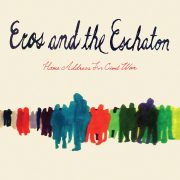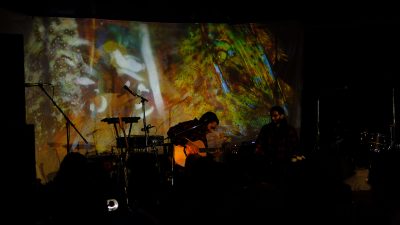Self-awareness and the fossilization of Electroclash: a sub-genre revisited

by Shaun Roncken
Like crooning the lyrics to “Glycerine” while tucking loose hair behind your ears, or mumbling a phallic joke in the shade of the Seattle Space Needle, an Electroclash jab provokes easy laughs. That said, Electroclash’s most fascinating attribute is the fact that its founding members considered themselves a punch-line from the moment of inception – when the scene’s boldest and brightest began aping Giorgio Moroder in high-profile Deitch galleries throughout Soho and Brooklyn.
“Casey Spooner and Warren Fischer are the first to admit that Fischerspooner started as a goof.”
The preceding passage is the crown that sits atop Carl Swanson’s 2003 Electroclash piece in The New York Times. “Mr. Spooner would burst onto the stage in a zebra-striped suit, lip-syncing over cheesy electronic samples or offering winking asides about his performance.”A streak of self-awareness was the cheeky grin that linked many of era’s pivotal acts, and you need not read a splashy quote from The New York Times to realize that Electroclash outfits didn’t take themselves too seriously. Listen to “Frank Sinatra“ by Miss Kittin & The Hacker or anything by Tracy and the Plastics, and you’ll realize their sense of humor cuts the same slice of cold cynicism that currently neuters the long-dead genre.
It was peculiar for an entire scene to be so acutely aware of its status as fleeting art form, and I think it might be the only movement to reference its impending doom at such a frequent rate so early in its development.
As I leafed through articles from the era, two things jumped out: 1) Pieces about the scene were predominantly written between 2001 – 2003, the artificial bookends of Electroclash, and 2) I could pinpoint the year a story was written based on its tone alone. In 2001, the majority of the pieces were swept up in the prevailing tide of new artists that had washed into Larry Tee’s Brooklyn club, Luxx. Tee was the premier curator of the era; Luxx hosted Berliniamsburg, an Electroclash dance party held Saturday nights, and he created the 2001 Electroclash Festival, which not only stamped the bands with a catch-all label, it gave the press a reason to finally write about them. Gavin McInnes’ glowing festival review for NME deemed Electroclash “the best thing to happen to New York since punk rock,”and was one of many articles that nudged the genre toward the mainstream.
In stark contrast to the stories of 2001, those in 2002 were discussed in grave, hushed tones. Countless pieces began by asking, “Is Electroclash dead?” Others prepared for the fallout, even predicting death by Christmas of that year. Perhaps the permanence of web writing was beginning to sink in, and writers felt they had to protect themselves by constantly questioning the existence of an era before its actual demise, making it easier to sidestep the embarrassment of Electroclash eventually going the way of Grunge.
By 2003, pangs of paranoia bore their fruit and the era had flamed out. Oddly enough, Entertainment Weekly was the publication to foreshadow its end in a cold, three sentence review of The Electroclash Mix by Larry Tee. It labeled the compilation “shallow (and) redundant…it can’t even qualify as irony.” Electroclash was unofficially padlocked two months later when The Village Voice reported that Luxx would have its last Berlinamsburg night on July 19th. An aesthetic once draped in postmodern praise had quickly fallen prey to pithy reviews by major outlets like Entertainment Weekly.
In retrospect, Larry Tee’s defense of the genre perfectly sums up the downfall of the scene. He once proclaimed, “They are fuckable, they have opinions. And they aren’t just regurgitating the ‘80s. When people say how ‘80s it is, I wonder if people actually think most kids grew up on Nitzer Ebb and DAF.“ While it’s true that most people didn’t grow up on Nitzer Ebb, Tee missed the point – once people got over the novelty of hearing the same band reference for the umpteenth time, the scene lost its cache. An audience’s familiarity with a reference is besides the point. References grow stale when 50 bands in a scene pull from the same 50 bands of a bygone era. Nobody wants to have the same experience on repeat, no matter how tongue in cheek the producers of those experiences may be.
Which leads us to a pressing question: does the fact that these artists knew their brand of music was a hollow joke, rescue them from the dregs of a derivative sub-genre? The same question is often asked of other art forms, ranging from Pop Art to stand-up comedy. Does Andrew Dice Clay’s claim that he was playing a crass character serve to elevate his act? Does being in on a gag elevate an unfunny joke to a hilarious one? Is being self-aware enough to legitimize an art form?
To remember that this genre’s top acts were in on the gag is to dull the teeth of present-day barbs to a degree, because they’re essentially recycling a joke the artists were making in the first place. This ultimately leaves very little behind, save a cycle of self-referential jabs that will continue to stare at themselves in a hall of mirrors until the end of time. And so, when we look at the remains of Electroclash, we’re peering at a serpent that ate its own tail because it suspected someone else might eat it first.













